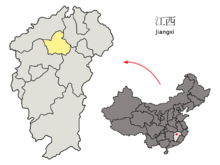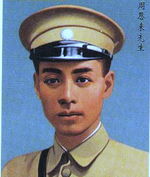- Nanchang Uprising
-
For the battle of Nanchang, fought during the Second Sino-Japanese War in 1939, see Battle of Nanchang.
Nanchang Uprising Traditional Chinese 南昌起義 Simplified Chinese 南昌起义 Transcriptions Mandarin - Hanyu Pinyin Nánchāng Qǐyì - Wade–Giles Nanch'ang Ch'ii Cantonese (Yue) - Yale Romanization Naam4 cheung1 Hei2 yi6 Alternative Chinese name Traditional Chinese 八一起義 Simplified Chinese 八一起义 Transcriptions Mandarin - Hanyu Pinyin Bāyī Qǐyì - Wade–Giles Pai Ch'ii Cantonese (Yue) - Yale Romanization Baat3 yat1 Hei2 yi6 The Nanchang Uprising (simplified Chinese: 南昌起义; traditional Chinese: 南昌起義; pinyin: Nánchāng Qǐyì) (August 1, 1927) was the first major Kuomintang-Communist engagement of the Chinese Civil War, in order to counter the anti-communist purges by the Nationalist Party of China.
The Kuomintang (KMT, or Nationalist Party) established a ‘Revolutionary Committee’ at Nanchang to plan the spark that was expected to ignite a widespread peasant uprising. Deng Yanda, Song Qingling (Soong Ching-ling, Madame Sun Yat-sen) and Zhang Fakui (who later crushed the uprising) were among the political leaders.[1]
Military forces in Nanchang rebelled under the leadership of He Long and Zhou Enlai attempting to seize control of the city after the end of the first Kuomintang-Communist alliance. Other important leaders in this event were Zhu De, Ye Ting, and Liu Bocheng.
Communist forces successfully occupied Nanchang and escaped from the siege of Kuomintang forces by August 5, withdrawing to the Jinggang Mountains of western Jiangxi. The day of August 1 was later regarded as the anniversary of the founding of the People's Liberation Army. It is regarded as the first action fought against the Kuomintang.
Contents
Names
In Chinese, apart from the name shown above, the event is known as: August 1 Nanchang Uprising (simplified Chinese: 八一南昌起义; traditional Chinese: 八一南昌起義), August 1 Uprising (simplified Chinese: 八一起义; traditional Chinese: 八一起義), Nanchang Rebellion (Chinese: 南昌起事), Nanchang Insurrection (simplified Chinese: 南昌暴动; traditional Chinese: 南昌暴動), or Nanchang Mutiny (simplified Chinese: 南昌兵变; traditional Chinese: 南昌兵變)
Order of battle
Communist forces
Communist force at its peak during Nanchang Uprising totaled over 20,000, though some of them did not join the battle until a day later. The entire communist force was organized into the 2nd Front Army, and over half of it was the force under He Long's command. He Long was also named as the Commander-in-Chief of the 2nd Front Army, and Ye Ting as the deputy commander-in-Chief and acting front line commander-in-chief. Communist representative was Zhou Enlai, chief of staff was Liu Bocheng, and director of Political Directorate of the 2nd Front Army: Guo Moruo. The following is the order of battle for the communist forces:
- 9th Army commanded by Zhou Enlai, with Zhu De as the deputy commander and Zhu Kejing (朱克靖) as the communist representative.
- 11th Army commanded by Ye Ting, with Cai Tingkai as the deputy commander and Nie Rongzhen as the communist representative.
- 10th Division commanded by Cai Tingkai
- 24th Division
- 25th Division commanded by Zhou Shidi (周士第)
- 20th Army commanded by He Long and Liao Qianwu (廖乾吾) as the communist representative
- 1st Division
- 2nd Division
- 3rd Division commanded by Zhou Yiqun (周逸群)
Battle at Nanchang
The rebellion was first planned to take place during the night of July 30. But due to complications with Zhang Guotao the rebellion was postponed.
On the morning of August 1 at exactly 2am, Zhou Enlai, He Long, Nie Rongzhen, Ye Ting, Ye Jianying, Lin Biao, Zhu De, Chen Yi and Liu Bocheng led their troops and attacked the city of Nanchang from different directions.
Four hours later, the Communist troops were able to take over the entire city of Nanchang. They were able to capture 5,000 small arms, and around 1,000,000 rounds of ammunition from the defenders of the city. Around noon, the Revolutionary Committee of the Chinese Nationalist Party (中國國民黨革命委員會) was established.
Jung Chang claims that the operation led by Zhou Enlai was supervised by Soviet military advisors. Their goal was to lead the troops to a coastal area in order to receive a supply of weapons from the Soviet Union.
Retreat
Facing a counter-attack from the Nationalists, the Communists decided to retreat towards the province of Guangdong to the south. Once there, they would try to take over the city of Guangzhou while spreading influence to the peasants and farms in that area.
 Location of Nanchang in China
Location of Nanchang in China
Disaster Foretold
- See also: Little Long March
Guangzhou was the target set by Comintern and, on August 3, the communist troops pulled out of Nanchang. their Little Long March came to an end at the beginning of October, as they came down out of the Hakka uplands and into the Chaoshan area: in Chaozhou they were defeated by the Nationalist-affiliated troops. The Communists were separated and went in two general directions, one retreated to Shanwei and engaged the Nationalists in guerrilla warfare, and the other went to southern Hunan and eventually joined the force under Mao Zedong, whose abortive Autumn Harvest Uprising had been no more successful.
After the serious defeat Chinese communists had suffered, only 1,000 soldiers remained as a complete unit, in a regiment. Under the command of Zhu De and Chen Yi who had faked their names, the remaining regiment sought refuge under a local warlord in Hunan. From this humble beginning, the force eventually grew to a 10,000 strong force and went to Jiangxi and joined Mao Zedong at Jinggangshan in April 1928.
Liu Bocheng became a fugitive but was lucky enough to find other communists who helped him and eventually sent him to the Soviet Union for military training, while Lin Biao deserted after the defeat but had to return to the communist force because of fear hostile locals would turn him in or kill him. Guo Moruo fled to Japan after the defeat.
Other surviving members were much less fortunate; all became fugitives. Zhou Enlai, Ye Jianying and Ye Ting lost contact with others and fled to Hong Kong with Zhou seriously ill. The three had two pistols with them and were successful in reaching Hong Kong. Nie Rongzhen, the other communist leader, also successfully escaped to Hong Kong.
He Long
He Long had strongly opposed the retreat plan. He accurately pointed out that marching a thousand miles in the heat of summer would put a severe strain on the troops, and also that the popular support for the communists in Guangdong was merely a fraction of the huge peasantry support in Hunan. In the opinion of He Long, the new communist base should be established in the border region of Hunan; He suggested that in Hunan the communist troops would be easily resupplied and their troops strengthened by the enlistment of the local populace. However, He Long's suggestion was vetoed.
He Long went home alone after the defeat. Reduced from an army commander in charge of tens of thousands of men to a beggar, he was not well received by his family except a few who were already communists. Soon, He Long would raise another 3,000 soldier strong communist force in his native home but it would soon be wiped out by the nationalists, with only less than three dozen members surviving. It would take year for He Long's force to recover again for the third time.
References
- ^ Schwartz, Benjamin, Chinese Communism and the Rise of Mao, Harper & Row (New York: 1951), p. 93.
- Jung Chang and Jon Halliday, Mao: The Unknown Story (London, 2005); Jonathan Cape, ISBN 0-679-42271-4
- Nanchang Mutiny http://www.republicanchina.org/NanchangMutiny-v0.pdf
External links
- http://81.china1840-1949.net.cn/qyjj.htm
- http://news.xinhuanet.com/ziliao/2003-07/28/content_996380.htm
Chinese Civil War Main events pre-1945 Main events post-1945 Specific articles -
- Nanchang Uprising
- Autumn Harvest Uprising
- Guangzhou Uprising
- Sino-Soviet conflict (1929)
- Encirclement Campaigns (1930–1934)
- Chinese Soviet Republic (1931–1934)
- Long March (1934–1936)
- Xi'an Incident (1936)
- Second United Front (1937–1946)
Part of the Cold War
- Full-scale Civil War (1946–1949)
- Kuomintang Islamic Insurgency in China (1950–1958)
- Campaign at the China–Burma Border (1960-1961)
- First Taiwan Strait Crisis (1955)
- Second Taiwan Strait Crisis (1958)
- Third Taiwan Strait Crisis (1996)
- Pan-Blue visits to mainland China (2005-)
- Political status of Taiwan
- Legal status of Taiwan
- Chinese reunification
- Taiwan independence
- Cross-Strait relations
Primary participants
Categories:- Conflicts in 1927
- Battles of the Chinese Civil War
- 1927 in China
- National Revolutionary Army
- Rebellions in China
- Nanchang
Wikimedia Foundation. 2010.

